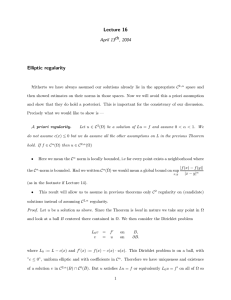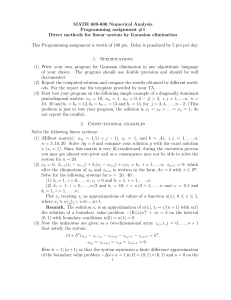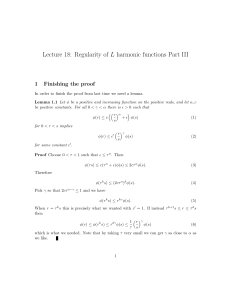Lecture 21 Higher Elliptic Regularity May 4th, 2004
advertisement
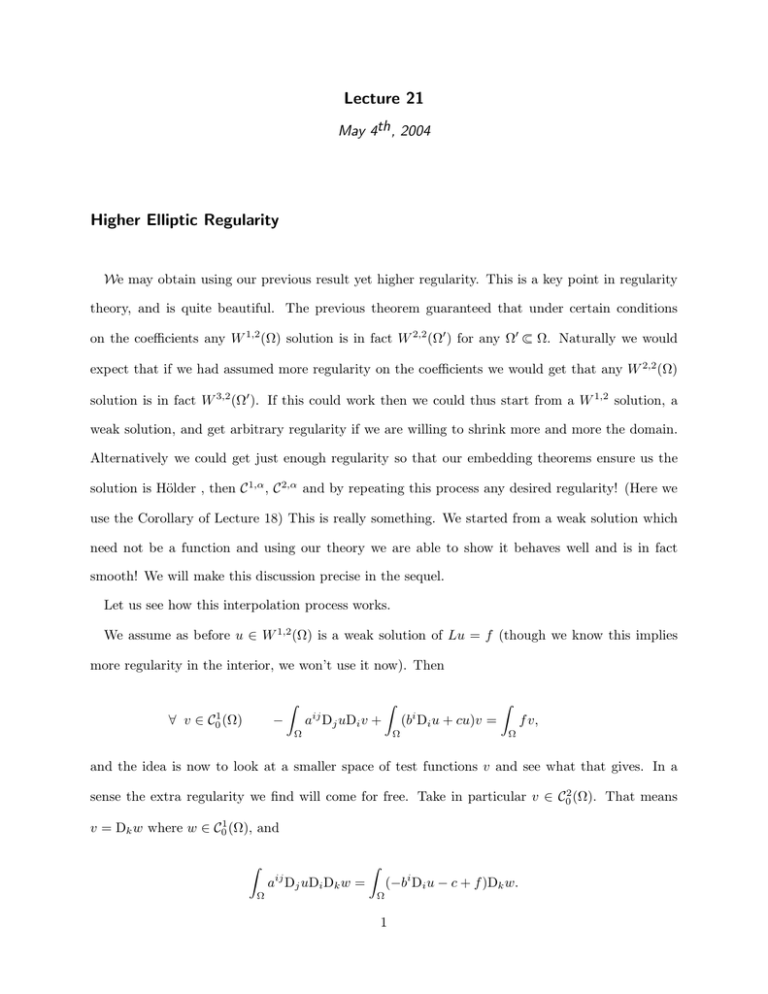
Lecture 21
May 4th , 2004
Higher Elliptic Regularity
We may obtain using our previous result yet higher regularity. This is a key point in regularity
theory, and is quite beautiful. The previous theorem guaranteed that under certain conditions
⊂ Ω. Naturally we would
on the coefficients any W 1,2 (Ω) solution is in fact W 2,2 (Ω′ ) for any Ω′ ⊂
expect that if we had assumed more regularity on the coefficients we would get that any W 2,2 (Ω)
solution is in fact W 3,2 (Ω′ ). If this could work then we could thus start from a W 1,2 solution, a
weak solution, and get arbitrary regularity if we are willing to shrink more and more the domain.
Alternatively we could get just enough regularity so that our embedding theorems ensure us the
solution is Hölder , then C 1,α , C 2,α and by repeating this process any desired regularity! (Here we
use the Corollary of Lecture 18) This is really something. We started from a weak solution which
need not be a function and using our theory we are able to show it behaves well and is in fact
smooth! We will make this discussion precise in the sequel.
Let us see how this interpolation process works.
We assume as before u ∈ W 1,2 (Ω) is a weak solution of Lu = f (though we know this implies
more regularity in the interior, we won’t use it now). Then
∀ v∈
C01 (Ω)
−
Z
ij
a Dj uDi v +
Ω
Z
i
(b Di u + cu)v =
Ω
Z
f v,
Ω
and the idea is now to look at a smaller space of test functions v and see what that gives. In a
sense the extra regularity we find will come for free. Take in particular v ∈ C02 (Ω). That means
v = Dk w where w ∈ C01 (Ω), and
Z
Ω
aij Dj uDi Dk w =
Z
(−bi Di u − c + f )Dk w.
Ω
1
Since w is twice continuously differentiable we may interchange derivatives above and integration
by parts yields
−
Z
ij
Dk (a Dj u)Di w =
Ω
Z
(−bi Di u − c + f )Dk w,
Ω
and
−
Z
ij
a Dk Dj uDi w =
Z
ij
Dk a Dj uDi w +
Ω
Ω
Z
(−bi Di u − c + f )Dk w,
Ω
and further
Z
ij
a Dj (Dk u)Di w =
Ω
Z
ij
i
[−Di (Dk a Dj u) + Dk (b Di u − c + f )] · w =:
Z
g · w,
Ω
Ω
which gives that Dk u is a weak solution of the second order equation
L̃(Dk u) = g
since this holds ∀ w ∈ C01 (Ω).
Now we note that L̃ = aij is strictly elliptic, and that if
•
aij ∈ C 1,1 (Ω)
•
bi , c ∈ C 0,1 (Ω)
•
u ∈ W 2,2 (Ω)
then we will have g ∈ L2 (Ω), and the Theorem of the previous lecture applies and we have Dk u ∈
⊂ Ω, i.e u ∈ W 3,2 (Ω′ ) as we wished to show. Indeed we get this extra regularity
W 2,2 (Ω′ ) ∀ Ω′ ⊂
seemingly for free and we may continue this for higher derivatives.
Let us see what kind of a priori estimates we get on the higher norms. From the Theorem we
have
||Dk u||W 2,2 (Ω′ ) ≤ c ||Dk u||W 1,2 (Ω) + ||g||L2 (Ω) .
≤ c ||u||W 2,2 (Ω) + ||u||W 1,2 (Ω) + ||u||W 2,2 (Ω) + ||f ||L2 (Ω)
2
where the last three terms come from the definition of g. We now shrink from Ω to Ω′ and from Ω′
to Ω′′ so that terms on the lhs are evaluated on Ω′′ and the ones on the rhs on Ω′ . But then those
terms on the rhs can be evaluated by Ω terms using our theorem once again! We get altogether
then
||Dk u||W 2,2 (Ω′′ ) ≤ c ||u||W 1,2 (Ω) + ||f ||L2 (Ω) .
We state this as the following
T heorem.
Let u ∈ W01,2 (Ω) be a weak solution of Lu = f in Ω, and assume
•
L strictly elliptic with (aij ) > γ · I, γ > 0
•
aij ∈ C k,1 (Ω̄)
•
bi , c ∈ C k−1,1 (Ω̄)
•
f ∈ W k,2 (Ω).
⊂ Ω, u ∈ W k+2,2 (Ω′ ) and
Then for any precompact set Ω′ ⊂
||u||W 2,2 (Ω′ ) ≤ C(||aij ||C k,1 (Ω) , ||b||C k−1,1 (Ω) , ||c||C k−1,1 (Ω) , λ, Ω′ , Ω, k, n) · ||u||W 1,2 (Ω) + ||f ||W k,2 (Ω) .
What we just did is the analogue in regularity theory of the technique we used in the Hölder part
of the course. As there, we want to differentiate the original equation but the lack of regularity
hinders us from doing do directly. We then take difference quotients and get bounds which now
allow us to differentiate and get all higher estimates. This shows us how special solutions of such
partial differetial equations are among general functions in those Sobolev Spaces.
Corollary.
Let u ∈ W01,2 (Ω) be a weak solution of Lu = f in Ω, and assume
•
L strictly elliptic with (aij ) > γ · I, γ > 0
•
f, aij , bi , c ∈ C ∞ (Ω̄)
Then on the whole domain, u ∈ C ∞ (Ω).
3
Proof. For all k ∈ N, f ∈ W k,2 (Ω)
⇒
⊂ Ω u ∈ W k+2,2 (Ω′ ). By the Sobolev Embedding
Ω′ ⊂
(Corollary to Lecture 18) then u ∈ C m (Ω′ ), m < k + 2 − n2 , hence u ∈ C ∞ (Ω′ ). Apply this reasoning
for Ω′ a ball around each point p ∈ Ω! to get u ∈ C ∞ (Ω). Smoothness is indeed a notion defined
pointwise.
Global Regularity (upto the boundary)
Up until now our regularity results were for the space W01,2 (Ω), i.e functions which vanish on ∂Ω.
We now study W 1,2 (Ω).
T heorem.
Suppose u ∈ W 1,2 (Ω) is a (weak) solution of Lu = f and assume
•
L strictly elliptic with (aij ) > γ · I, γ > 0
•
aij ∈ C 0,1 (Ω̄)
•
bi , c ∈ L∞ (Ω̄)
•
f ∈ L2 (Ω)
•
Ω has C 2 boundary.
•
∃ ϕ ∈ W 2,2 (Ω) such that u − ϕ ∈ W01,2 (Ω).
Then u ∈ W 2,2 (Ω) = W 2,2 (Ω̄) on all of Ω with
||u||W 2,2 (Ω′ ) ≤ C(||aij ||C 0,1 (Ω) , ||b||C 0 (Ω) , ||c||C 0 (Ω) , λ, Ω′ , Ω, ∂Ω, n)·
· ||u||W 1,2 (Ω) + ||f ||L2 (Ω) + ||ϕ||W 2,2 (Ω) .
Note that even for the 0 boundary values case this theorem gives a stronger conclusion: regularity
upto the boundary with a uniform estimate on all of Ω. The price is the assumption that the
boundary is regular enough.
4
Proof. We reduce to the zero boundary case in the usual manner. Suppose we could prove the
Theorem for all zero boundary Dirichlet Problems. Then for the problem L(u − ϕ) = f ′ := f − Lϕ
on Ω, u − ϕ = 0 on ∂Ω (this is precisely the assumption u − ϕ ∈ W01,2 (Ω)) we would have the
desired estimates
||u − ϕ||W 2,2 (Ω′ ) ≤ C · ||u − ϕ||W 1,2 (Ω) + ||f − Lϕ||L2 (Ω)
⇒
||u||W 2,2 (Ω′ ) ≤ C · ||u||W 1,2 (Ω) + ||f ||L2 (Ω) + ||ϕ||W 2,2 (Ω) ,
since ϕ ∈ W 2,2 (Ω) and L is of second order.
So we assume indeed u ∈ W01,2 (Ω). We now take a neighborhood containing a boundary portion
and map it through a C 2 diffeomorphism ψ (i.e ψ −1 exists and is C 2 ) onto Rn with the boundary
portion mapping into the hyperplane {xn = 0}.
We pull back everything onto the flat boundary situation using (ψ −1 )⋆ – the original equation is
∀ v∈
C01 (Ω)
−
Z
ij
a Dj uDi v +
Ω
Z
i
(b Di u + cu)v =
Z
f v,
Ω
Ω
and the pulled-backed one
∀ v ◦ ψ −1 ∈ C01 (ψ(Ω))
−
Z
Jac(ψ −1 )aij ◦ ψ −1 (ψ −1 )⋆ Dj u(ψ −1 )⋆ Di v
ψ(Ω)
+
Z
Jac(ψ
−1
i
)(b ◦ ψ
ψ(Ω)
−1
(ψ
−1 ⋆
) Di u + c ◦ ψ
−1
)v ◦ ψ
−1
=
Z
f v.
Ω
As we can assume ψ −1 preserves the given orientation of Rn and it is a diffeomorphism then
Jac(ψ −1 ) > 0 and therefore we still have a strictly elliptic equation L̃ũ = f˜ and the C 2 of ψ −1 guarantees the f˜ ∈ L2 (Ω) and that ãij is still Lipschitz, and bi and c still bounded (e.g. (ψ −1 )⋆ (bi Di u) =
bi ◦ ψ −1 · (ψ −1 )⋆ Di u = bi ◦ ψ −1 · Di (ψ −1 )⋆ u = bi ◦ ψ −1 · Di (u ◦ ψ −1 ) = bi ◦ ψ −1 · Dk u · Di (ψ −1 )k
(summation over k)).
Now we note that the difference quotients proof from last time still works for ∆hl ũ for each
of the directions l = 1, . . . , n − 1 tangent to the boundary. So by applying that Theorem we
5
get Dl ũ ∈ W 1,2 (ψ(Ω′ )) and hence Dij ũ ∈ L2 (ψ(Ω′ )) except for i = j = n. Since ψ is a C 2
diffeomorphism, the same holds for u.
So in order to finish the proof we go back to the proof. We have W 2,2 except possibly in the
boundary, so may write the equation
Lu = aij Di ju + Di aij Dj u + bi Di u + c · u = f,
a.e. All terms are in L2 except ann Dnn u. But then isolating it on one side of the equation we see
it must be as well, so it can not blow up at the boundary.
So now indeed we are done: we cover all of Ω̄ with a finite number of small ball cover the
boundary portion and another Ω′ covering the rest of the interior and we have the desired estimate
on each of those domains.
We now have higher regularity upto the boundary:
Corollary.
Let u ∈ W 1,2 (Ω) be a weak solution of Lu = f in Ω, and u = ϕ on ∂Ω (i.e
u − ϕ ∈ W01,2 (Ω)) and assume
•
L strictly elliptic with (aij ) > γ · I, γ > 0
•
aij ∈ C k,1 (Ω̄)
•
bi , c ∈ C k−1,1 (Ω̄)
•
f ∈ W k,2 (Ω).
•
∂Ω is C k+2 .
Then u ∈ W k+2,2 (Ω) uniformly on the whole domain and
||u||W k+2,2 (Ω)
≤ C(||aij ||C k,1 (Ω) , ||b||C k−1,1 (Ω) , ||c||C k−1,1 (Ω) , λ, ∂Ω, Ω′ , Ω, k, n) · ||u||W 1,2 (Ω) + ||f ||W k,2 (Ω) + ||ϕ||W k+2,2 (Ω) .
If k = ∞ then u ∈ C ∞ (Ω̄).
6
The only difference from the compactly supported case is that we need now to have at our
disposal a modified Sobolev Embedding: W k+2,2 ⊆ C m (Ω̄) instead of the one we proved with
W0k+2,2 ⊆ C m (Ω̄). This is indeed the case as one can show by modifying the latter’s proof under
the assumption of smooth enough boundary.
Improvement of our estimate
Assume u ∈ W01,2 (Ω), Lu = f ∈ L2 (Ω), aij , bi , c ∈ L∞ (Ω). Then
||u||W 2,2 (Ω) ≤ c · ||u||L2 (Ω) + ||f ||L2 (Ω) .
Proof. During the proof which involved the W 1,2 (Ω) norm on the rhs we arrived at the inequality
λ||Du||L2 (Ω) ≤
Z
aij Di uDj ϕ =
Ω
Z
(−bi Di u − cu + f )ϕ
Ω
for all test functions ϕ ∈ C01 (Ω) but in fact also for all test functions in the completion W01,2 (Ω)! In
particular we can take ϕ = u ! But actually for ϕ = u we can get this directly just from the strict
ellipticity without having to go through the difference quotients process (just true for this special
choice of v !). In particular we needn’t assume more than L∞ (Ω) regularity on the aij now! We
continue then and get
λ||Du||L2 (Ω) ≤
Z
ij
a Di uDj u =
Z
(−bi Di u − cu + f )u
Ω
Ω
=−
Z
i
(−b u(Di u) +
1
ǫ
2
Z
(−cu2 + f u)
Ω
Ω
≤
Z
|Du|2 +
Ω
Z
n
X
11
i=1
2ǫ
|bi u|2 +
Ω
Z
(−cu2 + f u).
Ω
For ǫ < λ one can move the first term to the lhs to conclude that (thanks to strict ellipticity we
can now divide out by λ and get a uniform bound!)
7
||Du||L2 (Ω) ≤
1
||u||L2 (Ω) + ||f ||L2 (Ω) .
2
Now we can plug this in to our original estimate to get the desired improvement
||u||W 2,2 (Ω) ≤ c · ||u||W 2,1 (Ω) + ||f ||L2 (Ω) .
= c · ||u||L2 (Ω) + ||Du||L2 (Ω) + ||f ||L2 (Ω) .
≤ c′ · ||u||L2 (Ω) + ||f ||L2 (Ω) .
Similarly this improvement applies to u ∈ W 1,2 (Ω) though it will not apply up to the boundary;
we will have
||u||W 1,2 (Ω′ ) ≤ c ||u||L2 (Ω) + ||f ||L2 (Ω)
by taking ϕ = η ·u with η = 1 on Ω′ and applying the above argument. If we want an estimate on all
of Ω we need to add a term ||ϕ||W 2,2 (Ω) to the rhs by applying the above result to u − ϕ ∈ W01,2 (Ω)
for f ′ := f − Lϕ.
8
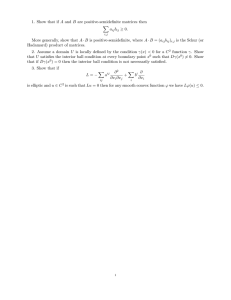
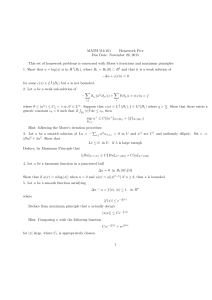
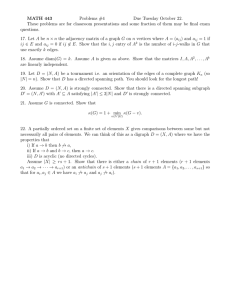

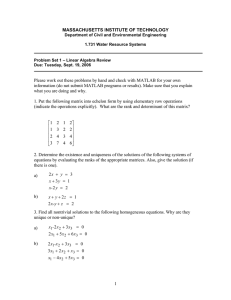
![1. Let R = C[x].](http://s2.studylib.net/store/data/010491179_1-9a9c70e395518f466f652079f02ae14a-300x300.png)
